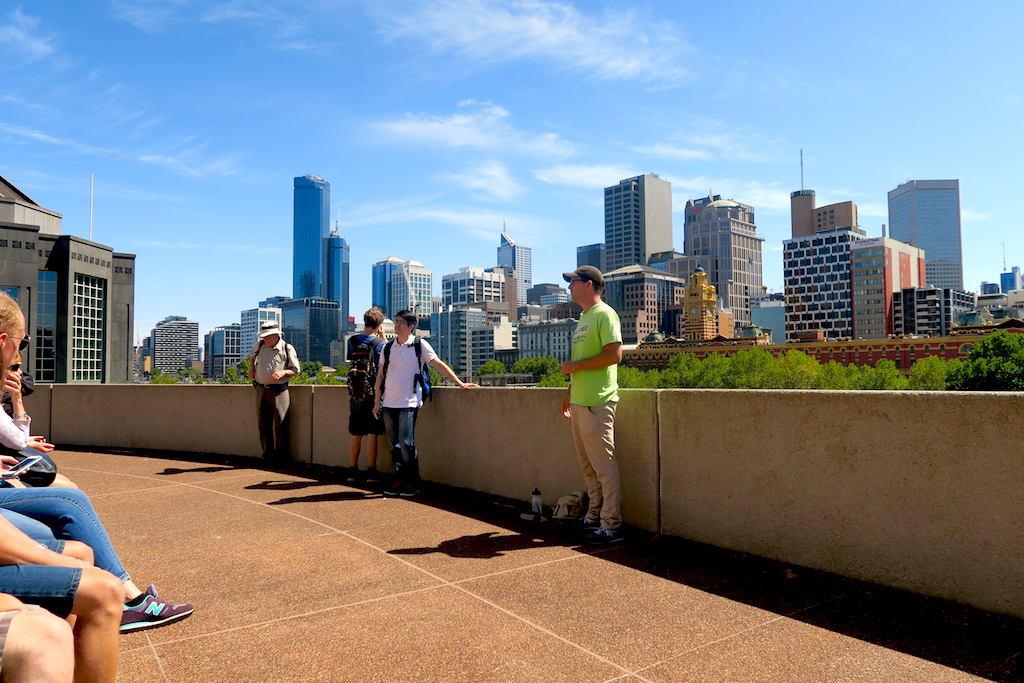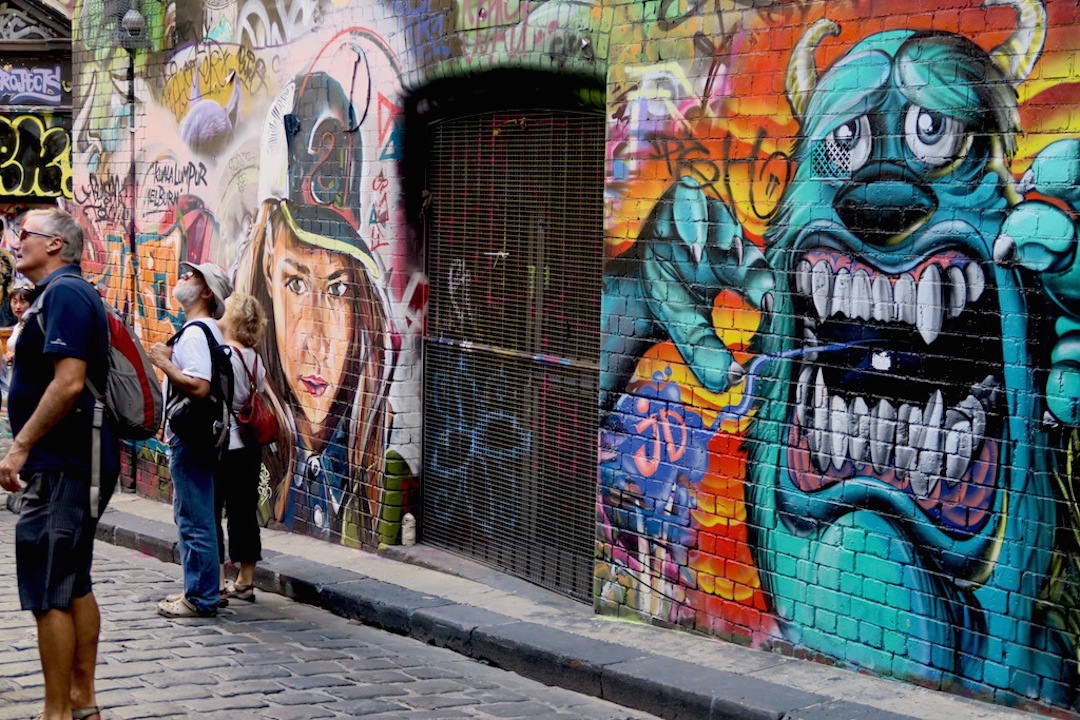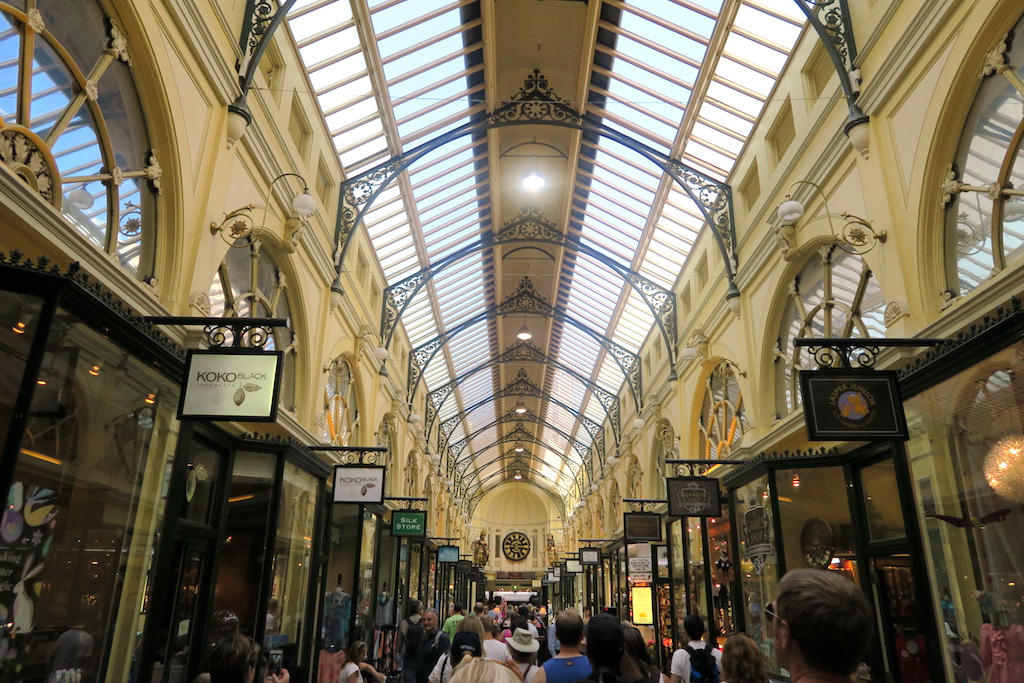
Tour guide Courtnay instructing the cohort of city walkers
To celebrate my one-year anniversary living in Melbourne I decided to go on a free walking tour to learn more about the city that I’ve been calling home for the past year. I’m slightly ashamed that it’s taken me 365 days to do this.
On this beautiful, and rare, sunny Melbourne morning a collection of 40 lost souls gathered at the statue of Sir Redmond Barry (most famously known as the man who committed Ned Kelly to the hangman’s noose) out the front of the State Library of Victoria, waiting for the command of our green shirt-clad guide, Courtnay.
We all introduced ourselves. Realising that everyone in the group was a tourist hailing from the likes of Malaysia, the UK, America, etc, I suddenly became self-conscious that this was my home city, which I knew nothing about. In a state of panic I introduced myself as Kylie from London. Apparently, as I told the group, I was here on a month-long holiday. Then I awkwardly realised I had to keep up this ridiculous faux accent for the entire three-hour tour. Sigh.
Melbourne history 101
The first half of the tour was a great history lesson learning the key players of Melbourne’s early foundings. Things I feel I should have learnt in a Melbourne primary school, like who the men are behind Collins and Bourke streets. For those taking part in today’s history lesson, it’s Lieutenant-Governor David Collins, explained below; and the Governor of New South Wales at the time, Sir Richard Bourke.
Hallelujah that I no longer need to rely on Wikipedia to stem my curiosity as to who this Collins, Bourke, Monash or La Trobe person must have been, and why there are so many God damn landmarks named after them.
Throughout the walking tour we also learnt the timeline of events that contributed to Melbourne being what it is today. We learnt how settlement of the area was originally in Sorrento (which was led by one Lieutenant-Governor David Collins, the namesake of Collins Street), 100 kilometres from today’s CBD. The Sorrento settlement ultimately failed and was moved to Tasmania, before a second attempt was made at the top of Port Phillip Bay some 30 years later in the late 1830s.
This second go was largely led by John Batman <insert long history spiel here that you should really Google>, which is said ‘batman’, not ‘bat–man’. Quickly, no pause, so you don’t turn an ex-Tasmanian farmer into a superhero character.
I thought Courtnay was joking when he said the city was originally, briefly, called Batmania, and that we all would have been Batmanians not Melburnians. However, the all-reliable source Wikipedia confirmed it to be true (and also the National Museum of Australia). I should have known a history student doesn’t joke about history.
Then we visited key 19th century buildings largely from the gold rush and Marvellous Melbourne eras that still punctuate the city streets, including the former Melbourne Magistrates’ Court, the Old Melbourne Gaol, Melbourne Exhibition Building and Victorian Parliament House.
I am Melbourne royalty!
I also learnt that Melbourne was named after the then Prime Minister of Great Britain, Lord Melbourne, who’s actual name was William Lamb. William Lamb, Kim Lamb, I think this makes me Melbourne royalty, and possibly the first time that I’ve eagerly embraced my married name, without using it in a North Korean dictator joke (all hail Kim Jean Lamb!).
More proof of this royalty: William Lamb’s wife was Lady Caroline Lamb, which just so happens to be the name of my mother-in-law. Upon telling her that her namesake is a pivotal player in Melbourne’s early history she demanded that we be given the keys to the city and free transport therein. Hear, hear.
Melbourne’s laneways
The second half of the tour was spent detouring down Melbourne’s laneways, starting with Crossley and Liverpool streets. Originally named Romeo Lane and Juliet Terrace, the two alleys were the heart of Melbourne’s red light district, home to thieves and prostitutes, before the area was cleaned up in the 1870s and their names consequently changed.
Then the tour criss-crossed through some of Melbourne’s best-known laneways and arcades, including graffiti-adorned Hosier Lane; Royal Arcade; Block Arcade, which was built in the 1890s to emulate the Galleria Vittorio Emanuele in Milan; and Tattersalls Lane in Chinatown, with it’s collection of cool bars.
Walking tour of Melbourne is…
Courtnay did a tremendous job at corralling 40+ people through the busy streets of Melbourne and also making himself heard without a mic. He was everything that you’d expect a university student majoring in history to be: incredibly knowledgeable, serious and passionate about Melbourne’s history.
Although it’s promoted as a free tour, tips are expected at the end. When you see people handing over golden pineapples you will feel guilted into gifting a tip that you can’t really afford because it’s a really good, informative tour of Melbourne.
By foot is a great way to discover the city, especially with a well-informed guide at the helm. Let’s just hope you behave a little more normal than I did. I really should have just owned up to not being up-to-date with my Melbourne history rather than having to fake an accent and remember an elaborate back-story. One that became incredibly awkward when the English backpackers invited me for a beer after the tour and wanted to exchange hometown stories. True story.
I’m Free Tours: Melbourne
Tours leave everyday, excluding Christmas Day, at 10:30am and 2:30pm from the Sir Redmond Barry statue out the front of the State Library of Victoria.
imfree.com.au/melbourne


